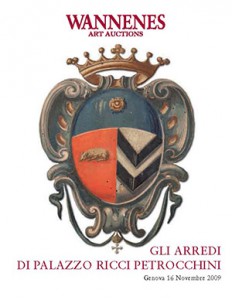Single property
THE PALACE RICCI PETROCCHINI IN POLLENZA
Built as a secondary residence, a country home for a family with its deepest roots in Macerata, Palazzo Ricci Petrocchini of Pollenza is blessed with a history that is both as interesting as it is dynamic. This was wholly emblematic of the rich social and cultural life of provincial aristocracy over the last few centuries. In the case of the Palazzo of Pollenza (previously known as Monte Milone), its history is of particularly interesting on account of the events in the lives of its inhabitants and the several important people who passed through its doors, from the sixteenth-century Cardinal Petrocchini to Matteo Ricci, right up to Alessandro Manzoni and Massimo d’Azeglio. The documented history of the residence, the Palazzo Ricci Petrocchini of Macerata – and also of what would become the family’s principal seat – started with Gregorio Petrocchini da Montelparo (1537-1612). He was a typical Counter-Reformation prelate and indeed his Augustinian origins were no barrier to a great career since he was made a Cardinal by Pope Sextus V (Peretti, 1585-1590) in 1589. He was an important Cardinal for his times and (lot 29) was an attentive patron of the arts (Cesare Ripa waited not one second before calling him…. mio Signore …in his famous work Iconologia). He was also a careful defender of his own prerogatives as is shown by his succinct reply in 1590 to the Grand Duke of Tuscany who interfered in the life of one of his protégés (with good reason it would later be revealed). However, the Cardinal would above all – as were the customs of the time – make the most of his time to make his family greater. Thus, he accumulated property and lands for his relatives and before all others the Palazzos of Macerata and Pollenza – built or rebuilt – that would one day pass on to his nephew, Giacomo Filippo. In 1622, his daughter, Gerolama, gave her whole inheritance and family coat of arms to her husband, Antonio Ricci, from a local aristocratic family (lot 94) illustrated, barely a generation previously, by another person of some prestige, the famous Matteo Ricci (1552- 1610). He was a much-celebrated religious and scholarly figure and played an important role in cultural relations between the East and the West. Recent research has only consolidated his fame. Ricci was a god-serving missionary who was intent on learning about and understanding Chinese civilisation, so different from our own. Ricci ended up playing a unique role in the Chinese Court and society – a role that would award him the privilege of being buried in the Forbidden City (a unique event in the history of the Celestial Empire). Meanwhile, his descendants continued to live the peaceful and elegant life of the Italian nobility in the Seventeenth and Eighteenth centuries. Peaceful but hardly so very provincial, if the family’s diaries are to be believed, since the family members showed a great interest in the ructions and innovations that spread through Italy and Europe during those long years. The first half of the Nineteenth century saw the two residences of Macerata and Pollenza still linked by a sort of trust with the likes of Alessandro Manzoni and Massimo d’Azeglio making occasional appearances. Giulia Manzoni would, as is known, one day marry Massimo d’Azeglio: their daughter, Alessandrina, would choose as a husband – much to her grandfather’s surprised enjoyment – the Marquis Matteo Ricci Petrocchini, from the Marches. The new century witnessed a more and more cultural approach to life in the Ricci houses. Clotilde married the maestro Gaetano Coronaro (1852-1908), a minor composer but much-appreciated in his time (he was a friend, among others, of Fogazzaro), whilst Andreina Coronaro was Fabio Failla’s mother (lot 237), a painter who was destined to enjoy a full career from the 1930’s onwards. The Palazzo di Macerata became, in the 1970’s, the seat of the Macerata Museum of Twentieth-Century Art and Pollenza, on the other hand, had continued until very recently to remain a family residence.
ART EXHIBITIONS
Wannenes Art Auctions selcts the best Art Ehibitions and Events everywhere in the world



